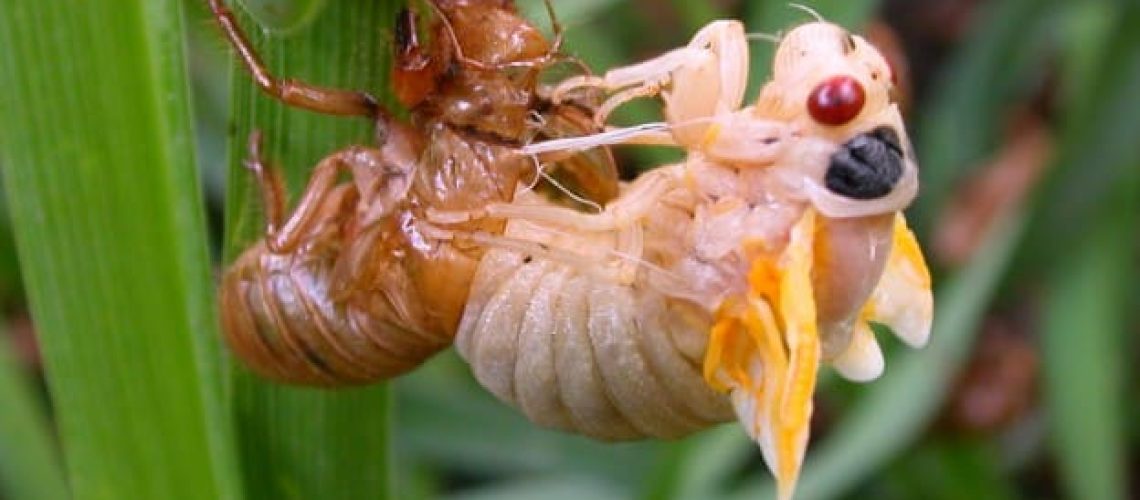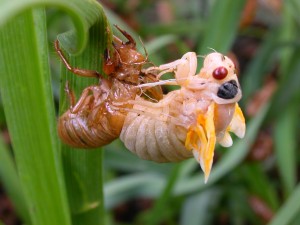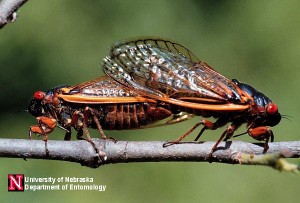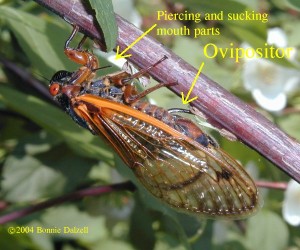Tree-lovers cannot help but feel unnerved by the emergence of cicadas this summer. The colossal bugs with bulbous red eyes emerge from the ground every 17 years. In the process, they litter tree trunks with freshly-shed shells and carcasses.
It’s a grotesque sight, yet what exactly are the cicadas doing? More importantly, what kind of damage do they incur on our trees? Here’s a brief explanation:
What are we seeing?
Known as the “largest insects of the order Homptera in North America,”* the cicada matures underground for 17 years, feeding off sap of tree and shrub roots. This year’s group is called “Brood 2.”) Once matured, the nymph cicada digs up to ground. She finds a vertical surface –typically a tree, telephone pole or fence—to molt, aka the process of shedding their nymph exterior for wings.
With wings in working order, the cicada flies to a tree for what many call the “mating frenzy.” Imagine spring break in Ft. Lauderdale heightened by the urgency of impending doom. There’s even an accompanying soundtrack, as males produce a loud buzzing song to attract the ladies.
The female cicada then lays her eggs, inserting her eggs into branches or twigs using a blade-like feature near her abdomen, known as an ovipositor. After six to ten weeks, the eggs hatch new cicadas, who drop from the tree and burrow back into the ground. That’s the last we see of Brood 2 cicadas until 2030. (Calculate how old you’ll be. It’s chilling.)
Do they damage trees?
Yes. When female cicadas insert their eggs inside twigs and branches, they can wound trees and make branches vulnerable to fungus. Sometimes, the wounds result in breakage, also known as “flagging.”
Luckily, mature trees tend to weather cicada season fairly well. However, according the Missouri Department of Conservation, flagging can damage saplings more severely. Aside from twigs and branches strewn about the ground, another tell-tale sign of flagging is large patches of brown leaves.
One thing to remember is that cicadas are not feeding on your trees. Nor will they bite humans or other animals. In fact, they barely eat above ground. They’re too busy molting, mating, laying eggs and dying.
How long will they be around?
Roughly 4 to 6 weeks for cicadas. However, “flagging” could show up later on during the summer. Just keep an eye out for brown spots and fallen branches.
How can I protect my trees from cicadas?
Do not try to combat cicadas with pesticides. Cicadas are ultimately part of our ecosystem –providing benefits to the environment—and deserve to be left to complete their life cycle. They aerate the ground by digging holes to emerge, and some argue that flagging rids trees of weak branches. Just sit back and let nature do its thing.
Cicada Sources:
- *“The Ultimate Guide to Backyard Bugs: Garden Insects of North America,” by Whitney Cranshaw, Princeton University Press, copyright 2004
- Absolutely fascinating video: http://vimeo.com/66688653
- WNYC offers this fun way to track Brood 2 in Northeast: http://project.wnyc.org/cicadas/



